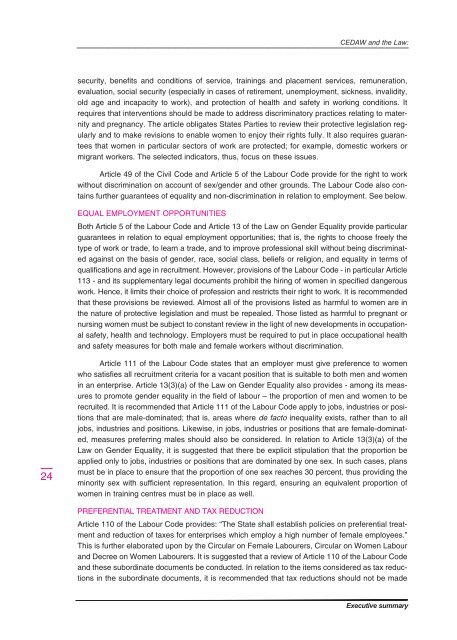English - CEDAW Southeast Asia
English - CEDAW Southeast Asia
English - CEDAW Southeast Asia
You also want an ePaper? Increase the reach of your titles
YUMPU automatically turns print PDFs into web optimized ePapers that Google loves.
<strong>CEDAW</strong> and the Law:<br />
security, benefits and conditions of service, trainings and placement services, remuneration,<br />
evaluation, social security (especially in cases of retirement, unemployment, sickness, invalidity,<br />
old age and incapacity to work), and protection of health and safety in working conditions. It<br />
requires that interventions should be made to address discriminatory practices relating to maternity<br />
and pregnancy. The article obligates States Parties to review their protective legislation regularly<br />
and to make revisions to enable women to enjoy their rights fully. It also requires guarantees<br />
that women in particular sectors of work are protected; for example, domestic workers or<br />
migrant workers. The selected indicators, thus, focus on these issues.<br />
Article 49 of the Civil Code and Article 5 of the Labour Code provide for the right to work<br />
without discrimination on account of sex/gender and other grounds. The Labour Code also contains<br />
further guarantees of equality and non-discrimination in relation to employment. See below.<br />
EQUAL EMPLOYMENT OPPORTUNITIES<br />
Both Article 5 of the Labour Code and Article 13 of the Law on Gender Equality provide particular<br />
guarantees in relation to equal employment opportunities; that is, the rights to choose freely the<br />
type of work or trade, to learn a trade, and to improve professional skill without being discriminated<br />
against on the basis of gender, race, social class, beliefs or religion, and equality in terms of<br />
qualifications and age in recruitment. However, provisions of the Labour Code - in particular Article<br />
113 - and its supplementary legal documents prohibit the hiring of women in specified dangerous<br />
work. Hence, it limits their choice of profession and restricts their right to work. It is recommended<br />
that these provisions be reviewed. Almost all of the provisions listed as harmful to women are in<br />
the nature of protective legislation and must be repealed. Those listed as harmful to pregnant or<br />
nursing women must be subject to constant review in the light of new developments in occupational<br />
safety, health and technology. Employers must be required to put in place occupational health<br />
and safety measures for both male and female workers without discrimination.<br />
24<br />
Article 111 of the Labour Code states that an employer must give preference to women<br />
who satisfies all recruitment criteria for a vacant position that is suitable to both men and women<br />
in an enterprise. Article 13(3)(a) of the Law on Gender Equality also provides - among its measures<br />
to promote gender equality in the field of labour – the proportion of men and women to be<br />
recruited. It is recommended that Article 111 of the Labour Code apply to jobs, industries or positions<br />
that are male-dominated; that is, areas where de facto inequality exists, rather than to all<br />
jobs, industries and positions. Likewise, in jobs, industries or positions that are female-dominated,<br />
measures preferring males should also be considered. In relation to Article 13(3)(a) of the<br />
Law on Gender Equality, it is suggested that there be explicit stipulation that the proportion be<br />
applied only to jobs, industries or positions that are dominated by one sex. In such cases, plans<br />
must be in place to ensure that the proportion of one sex reaches 30 percent, thus providing the<br />
minority sex with sufficient representation. In this regard, ensuring an equivalent proportion of<br />
women in training centres must be in place as well.<br />
PREFERENTIAL TREATMENT AND TAX REDUCTION<br />
Article 110 of the Labour Code provides: “The State shall establish policies on preferential treatment<br />
and reduction of taxes for enterprises which employ a high number of female employees.”<br />
This is further elaborated upon by the Circular on Female Labourers, Circular on Women Labour<br />
and Decree on Women Labourers. It is suggested that a review of Article 110 of the Labour Code<br />
and these subordinate documents be conducted. In relation to the items considered as tax reductions<br />
in the subordinate documents, it is recommended that tax reductions should not be made<br />
Executive summary

















